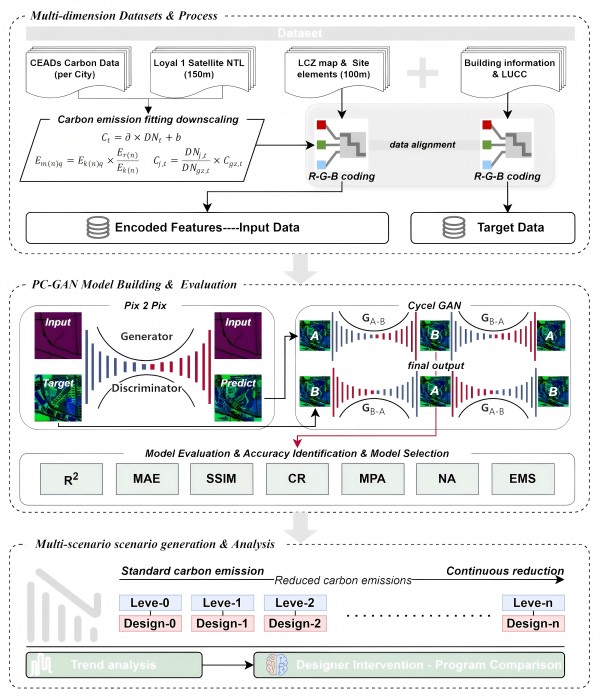Speaker
Description
Optimizing urban morphology is a pivotal strategy for reducing carbon emissions, thereby fostering sustainable urban development (Gurney et al., 2015). In this context, human-machine collaboration significantly enhances the efficiency and scientific rigor of urban morphological design. However, traditional methods often rely on post-evaluation processes, which are inefficient and fail to support goal-oriented, creative design solutions directly (Yuan et al., 2021). The advent of generative algorithms presents a transformative opportunity to advance these workflows (Zhou et al., 2023), thereby integrating technological innovation into the optimization of urban morphology.
To this end, this study develops an automated block design tool based on deep generative methods, termed the PC-GAN model, aimed at providing precise and efficient design schemes for carbon emission reduction in urban development. The PC-GAN model builds upon the single-step Pix2pix network architecture by integrating a two-step generative adversarial network (GAN) mechanism that incorporates the CycleGAN framework. This hybrid approach leverages the strengths of both models: Pix2pix effectively captures the nonlinear regression relationships between input conditions and output urban morphology, while CycleGAN enhances clarity restoration and optimizes the morphology of specific elements. By generating high-resolution, three-dimensional urban morphology schemes that establish a direct correspondence between urban morphology and carbon emissions, the model facilitates automated optimization tailored to specific climatic conditions, architectural styles, and carbon emission reduction targets. The PC-GAN model enables the rapid generation of carbon-efficient urban designs in the initial stages of planning while offering creative flexibility, allowing urban planners to explore diverse configurations aligned with carbon reduction goals (see Fig. 1 for the detailed technical workflow).
To further investigate the relationship between urban morphology and carbon emissions, this study utilizes the Local Climate Zone (LCZ) classification system to analyze urban blocks in Guangzhou. The LCZ system, which categorizes urban areas based on land use, morphology, and climatic factors, provides a framework for identifying carbon emission differences across zones. This classification facilitates the precise identification of differences in carbon emission optimization across zones, providing scientific support for targeted carbon emission reduction strategies. The study focuses on three representative LCZ types—LCZ4, LCZ5, and LCZ6—and develops iterative urban morphology optimization schemes with a 1% stepwise reduction in baseline carbon emissions.
Experimental results demonstrate that the PC-GAN model exhibits exceptional performance in both generation accuracy and carbon emission prediction. Specifically, the structural similarity index (SSIM) of the generated images reaches 0.87, and the coefficient of determination (R²) for carbon emission prediction achieves 0.90. In comparison, the traditional Pix2pix model attained an SSIM of 0.82 and an R² of 0.86. The PC-GAN model significantly enhances generation accuracy and adaptability in complex urban environments, particularly in generating key elements such as building layouts, green spaces, and impervious surfaces. Furthermore, the stepwise 1% iterative optimization method reveals distinct carbon emission optimization characteristics across different LCZ types, thereby providing robust support for developing region-specific carbon emission reduction strategies.
In conclusion, the PC-GAN-driven automated block design tool demonstrates high efficiency, precision, and superior texture generation capabilities, thereby significantly enhancing the quality of urban planning and design. This tool offers an innovative technological solution for carbon emission optimization and reduction, advancing the implementation of carbon emission reduction urban design concepts and providing new directions and frameworks for future urban morphology optimization. Furthermore, it provides methodological and technical framework references for optimizing other urban objectives, such as urban cooling.

References
Gurney, K.R. et al. (2015) Climate change: Track urban emissions on a human scale , Nature, 525(7568), pp. 179–181.
Yuan, P.F. et al. (2021) An architectural building cluster morphology generation method to perceive, derive, and form based on cyborg-physical wind tunnel (CPWT) , Building and Environment, 203, p. 108045.
Zhou, S. et al. (2023) Automatic responsive-generation of 3D urban morphology coupled with local climate zones using generative adversarial network , Building and Environment, 245, p. 110855.
| Keywords | Carbon emission; Urban morphology; GAN; Human-Machine collaboration; Guangzhou |
|---|

